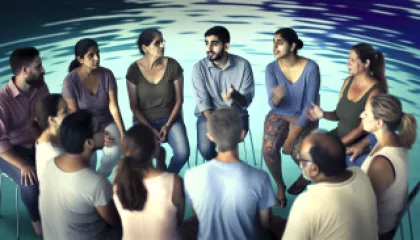The Power of Emotional Detachment: A Personal Perspective
As human beings, we often find ourselves entangled in a web of emotions. Our feelings can dictate our thoughts, actions, and overall well-being. However, there are times when emotional attachment can become overwhelming, leading to negative consequences. In such situations, emotional detachment can be a powerful tool for self-preservation and personal growth.
The Definition of Emotional Detachment
Emotional detachment refers to the ability to separate oneself from intense emotions and maintain a sense of calm objectivity. It involves creating a healthy distance from emotional situations, allowing for a clearer perspective and rational decision-making. While it may sound cold or unfeeling, emotional detachment is not about suppressing emotions or becoming apathetic. Instead, it is a practice that fosters emotional well-being and resilience.
It is important to note that emotional detachment should not be mistaken for avoidance or dissociation. Avoidance involves actively ignoring or running away from emotions, while dissociation is a defense mechanism that disconnects one from their feelings entirely. Emotional detachment, on the other hand, entails acknowledging and understanding emotions while choosing not to be overwhelmed by them.
Healing Emotional Detachment
The process of healing emotional detachment begins with self-awareness and introspection. It requires a willingness to examine one's own emotional patterns and triggers. By understanding the root causes of emotional detachment, individuals can begin to address any unresolved issues and develop healthier coping mechanisms.
Therapy can be a valuable resource for those seeking to heal emotional detachment. A trained therapist can provide guidance, support, and tools to navigate complex emotions and foster emotional connection. Through various therapeutic approaches such as cognitive-behavioral therapy (CBT) or psychodynamic therapy, individuals can gain insight into their emotional landscape and work towards achieving a healthy balance between detachment and connection.
The Benefits of Emotional Detachment
Emotional detachment, when practiced in a healthy and balanced manner, can have numerous benefits for one's overall well-being. It allows individuals to:
- Gain Clarity: By detaching from intense emotions, individuals can gain a clearer perspective on challenging situations. This clarity enables better decision-making and problem-solving.
- Promote Inner Peace: Emotional detachment can help create a sense of inner peace and tranquility. It provides a buffer against external stressors and allows individuals to maintain their emotional equilibrium.
- Cultivate Resilience: Detaching from emotions can enhance resilience, as individuals become less reactive to adversity and more adaptable to change.
- Enhance Relationships: Paradoxically, emotional detachment can improve interpersonal relationships. By maintaining emotional balance, individuals can engage with others from a place of empathy and understanding rather than being overwhelmed by their own emotions.
Dealing with Emotional Detachment
While emotional detachment can be beneficial, it is important to strike a balance to avoid becoming emotionally disconnected or detached from others. Here are some strategies for dealing with emotional detachment:
- Practice Mindfulness: Engaging in mindfulness exercises can help individuals stay present and connected to their emotions without being overwhelmed by them. Mindfulness allows for the observation of thoughts and feelings in a non-judgmental manner.
- Cultivate Self-Compassion: Developing self-compassion involves treating oneself with kindness and understanding. It is essential to acknowledge that emotions are a natural part of the human experience and to offer oneself support and care.
- Seek Support: Building a support network of trusted friends, family, or professionals can provide a safe space for emotional expression and exploration. Sharing emotions with others can foster connection and prevent excessive detachment.
- Engage in Emotional Regulation Techniques: Learning and practicing techniques such as deep breathing exercises, journaling, or engaging in creative outlets can help regulate emotions effectively.
- Challenge Negative Beliefs: Often, emotional detachment is rooted in negative beliefs about oneself or relationships. Challenging and reframing these beliefs can foster healthier emotional connections.
A Personal Perspective on Emotional Detachment
My name is Eliana Jackson, and I would like to share my personal perspective on emotional detachment. As someone who has struggled with overwhelming emotions throughout my life, I discovered the power of emotional detachment as a means of self-preservation and personal growth.
For years, I found myself easily entangled in the emotions of others. Their joy became my joy, their pain became my pain. It was exhausting and ultimately detrimental to my own well-being. Through therapy and self-reflection, I learned that emotional detachment does not mean being cold or unfeeling. It means finding a healthy balance between empathy and self-preservation.
By practicing emotional detachment, I have gained clarity and a deeper understanding of my own emotions. I am no longer overwhelmed by the emotional storms of others, and I can approach challenging situations with a calm and rational mindset. This newfound sense of emotional balance has allowed me to cultivate stronger, more authentic connections with those around me.
Emotional detachment has also provided me with a sense of inner peace and resilience. I am better equipped to handle adversity and change, as I no longer allow my emotions to dictate my every move. I have learned to create healthy boundaries and prioritize my own well-being while still being present for others.
While emotional detachment may not be the answer for everyone, I believe it is a powerful tool that can contribute to our overall emotional well-being. By understanding ourselves and our emotions, we can navigate life's challenges with clarity, resilience, and compassion.
"Emotional detachment is not about suppressing emotions or becoming apathetic. Instead, it is a practice that fosters emotional well-being and resilience."Source
"By detaching from intense emotions, individuals can gain a clearer perspective on challenging situations. This clarity enables better decision-making and problem-solving."Source
In conclusion, emotional detachment, when practiced in a healthy and balanced manner, can be a powerful tool for personal growth and well-being. It allows individuals to navigate intense emotions with clarity and resilience, fostering healthier relationships and promoting inner peace. Remember, emotional detachment is not about disconnecting from emotions altogether, but rather finding a healthy balance between detachment and connection. By embracing emotional detachment as a practice, we can empower ourselves to lead more fulfilling lives.






